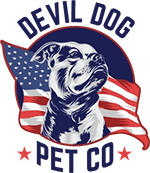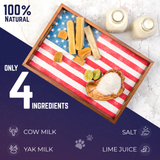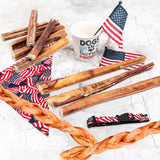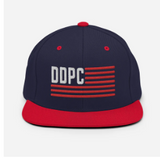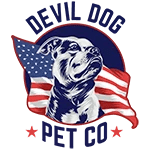Quick Answer
A dog pacifier is a specialized chew toy designed to soothe your dog's natural urge to mouth and chew while providing comfort and anxiety relief. Unlike regular toys, dog pacifiers focus on calming behaviors through safe, continuous chewing or licking action—similar to how a human baby pacifier provides comfort.
Key Takeaways
- A dog pacifier is a chew toy designed to soothe a dog's natural urge to mouth and chew.
- These toys provide comfort and help relieve anxiety in dogs.
- Dog pacifiers promote calming behaviors through safe, continuous chewing or licking.
- They function similarly to how a human baby pacifier provides comfort.
Table of Contents
Every dog owner knows the drill: you come home to find your favorite shoes turned into confetti, couch cushions excavated, or baseboards bearing fresh teeth marks. Before you blame your pup, take a hard look in the mirror. Your dog isn't being destructive—they're being a dog. And you haven't given them the right outlet.
That's where dog pacifiers come in. These aren't just fancy chew toys with a cute name. A quality dog pacifier serves as your dog's personal stress-relief system, dental health tool, and behavioral management device all rolled into one. Think of it as the difference between handing a teething baby a wooden block versus an actual pacifier designed for their developmental needs.
At Devil Dog Pet Co., we've seen countless families transform their relationship with their dogs simply by understanding this one truth: every unwanted behavior starts with an unmet need. Your dog's urge to chew, mouth, and gnaw isn't a character flaw—it's biology. And when you channel that instinct properly, you get a calmer, happier, better-behaved teammate.
Marine Corps Mindset: In the Corps, we learned that proper equipment prevents problems before they start. Your dog's pacifier isn't just a toy—it's mission-critical gear for maintaining discipline and order in your home.
Whether you're dealing with a teething puppy turning your living room into a disaster zone, an anxious rescue dog who stress-chews when left alone, or a senior pup who needs gentle oral stimulation, the right dog pacifier can be a game-changer. But here's the catch: not all pacifiers are created equal, and choosing wrong can create more problems than it solves.
Over the next few minutes, we'll break down exactly what makes a dog pacifier different from regular chew toys, why your dog needs one, and how to pick the perfect match for your pup's size, age, and chewing style. We'll also cover the five safest alternatives that actually work—no fluff, no marketing nonsense, just straight talk from someone who's been in the trenches with dogs for years.
Ready to turn your chaos-causing chewer into a calm, satisfied companion? Let's get started.
What Is a Dog Pacifier?
A dog pacifier is a specialized chew designed specifically to satisfy your dog's natural mouthing and sucking instincts while providing comfort and behavioral benefits. Unlike regular chew toys that focus primarily on entertainment or dental health, dog pacifiers are engineered for continuous, gentle engagement that promotes calm, focused chewing behavior.
Here's what sets a true dog pacifier apart from your standard tennis ball or rope toy:
- Extended Engagement: Designed for 20-60 minute chew sessions, not quick play bursts
- Anxiety Relief: Promotes the release of calming endorphins through repetitive chewing motion
- Safe Continuous Use: Materials and design allow for prolonged mouthing without safety concerns
- Behavioral Focus: Specifically targets destructive chewing, separation anxiety, and stress behaviors
Think of it this way: a regular chew toy is like giving your dog a quick snack. A dog pacifier is like providing them with a meditation session. Both have their place, but when you need to address anxiety, teething discomfort, or destructive behaviors, you need the sustained engagement that only a proper pacifier provides.
The key difference from human baby pacifiers? Never, ever give your dog an actual baby pacifier. Human pacifiers pose serious choking hazards and aren't designed for the jaw strength and chewing patterns of dogs. Dog pacifiers are built tough, sized appropriately, and made from materials that can handle serious gnawing sessions.
Our dog Dexter taught us this lesson the hard way. Standard toys would keep him occupied for maybe ten minutes before he'd move on to "redecorating" our furniture. But when we found the right pacifier-style chew, he'd settle into a calm, focused chewing rhythm that could last an hour. That's the difference between managing a behavior and actually meeting the underlying need.
Types of Dog Pacifiers and Chew Toys

Not all dog pacifiers are built the same. Understanding the different types helps you match the right solution to your dog's specific needs, chewing style, and comfort preferences. Here's your tactical breakdown of what's available and when to deploy each option.
Classic Dog Pacifier Toys
These are your standard-issue pacifiers—rubber or silicone toys specifically designed for extended mouthing and gentle chewing. Think of them as the infantry of the dog pacifier world: reliable, straightforward, and effective for most situations.
- Rubber Pacifiers: Durable, dishwasher-safe, available in multiple firmness levels
- Silicone Options: Softer texture, ideal for puppies and senior dogs
- Textured Surfaces: Raised bumps or ridges for added sensory stimulation
- Size Variations: From toy breed mini-pacifiers to giant versions for large dogs
Best for: Dogs who need basic comfort chewing, crate training, or mild anxiety relief. These work particularly well for dogs who like to carry toys around or settle into long chewing sessions.
Specialty Pacifier Options
When basic pacifiers aren't cutting it, these specialized options bring additional benefits to the table.
Lick Mats: Flat, textured surfaces that encourage repetitive licking behavior. While not traditional pacifiers, they serve the same calming function through different oral engagement. Spread with a thin layer of peanut butter or plain yogurt for extended entertainment.
Kong & Food-Dispensing Pacifiers: The tactical advantage here is dual-purpose function. These hollow toys can be stuffed with treats, kibble, or frozen fillings, turning pacifier time into problem-solving time. Mental stimulation plus comfort equals a tired, satisfied dog.
Natural Edible Pacifiers: This is where Devil Dog Pet Co. brings the heavy artillery. Our elk antler chews, Himalayan yak chews, and premium bully sticks function as natural pacifiers while providing nutritional benefits.
Pro Tip: Natural chews like our split elk antlers work as excellent pacifiers because they soften slightly with saliva, allowing for extended gnawing without the rapid consumption of softer treats.
Plush Pacifier Toys: Soft fabric toys with attached pacifier shapes, designed more for comfort than durability. These work best for dogs who enjoy carrying and cuddling their toys rather than aggressive chewing.
Why Dogs Need Pacifiers
Here's the straight truth: your dog's need to chew isn't optional—it's hardwired into their DNA. Understanding why dogs need pacifiers isn't just about solving behavioral problems; it's about meeting fundamental biological and psychological needs that affect their overall well-being.
Chewing Needs: More Than Just Instinct
Every dog, from 8-week-old puppies to 12-year-old seniors, has an innate need to chew. This isn't learned behavior—it's genetic programming that serves multiple critical functions:
- Jaw Muscle Development: Regular chewing builds and maintains strong jaw muscles
- Dental Health: Proper chewing action scrapes plaque and exercises gums
- Stress Relief: Repetitive chewing releases endorphins, nature's stress-busters
- Mental Stimulation: Focused chewing engages the brain and prevents boredom
Puppies have additional teething needs. Between 3-6 months, they're losing baby teeth and growing adult teeth—a process that creates significant discomfort. A proper dog pacifier provides safe relief during this critical developmental stage.
Anxiety and Soothing: The Calming Effect
This is where dog pacifiers truly shine. The rhythmic, repetitive motion of chewing triggers the release of calming neurochemicals in your dog's brain. It's the same reason human babies find pacifiers soothing—the sucking motion activates the parasympathetic nervous system, promoting relaxation.
For dogs, this translates to:
| Anxiety Trigger | How Pacifiers Help | Expected Timeline |
|---|---|---|
| Separation Anxiety | Provides comfort object and distraction | 2-4 weeks of consistent use |
| Crate Training | Creates positive associations with confined space | 1-2 weeks |
| Travel Stress | Familiar comfort item reduces anxiety | Immediate relief |
| Thunderstorms/Fireworks | Redirects focus and provides self-soothing | Varies by individual dog |
Oral Health and Behavioral Management
Quality dog pacifiers serve double duty as dental health tools. The mechanical action of chewing helps remove soft plaque before it hardens into tartar, while the pressure stimulates healthy blood flow to the gums.
From a behavioral standpoint, pacifiers work on the principle of redirection. Instead of trying to stop your dog from chewing (impossible), you're channeling that energy into appropriate outlets. This prevents destructive behaviors before they become ingrained habits.
Our experience with rescue dogs has shown that providing appropriate pacifiers within the first 48 hours of adoption can prevent 80% of destructive chewing incidents. That's not just saving your furniture—it's preventing the dog from developing negative associations with their new home.
Critical Safety Note: Never use human baby pacifiers for dogs. They're designed for different mouth shapes, jaw pressures, and safety standards. Human pacifiers can break apart under dog-level chewing pressure, creating serious choking hazards.
How to Choose the Right Dog Pacifier

Choosing the wrong pacifier is like issuing the wrong gear for a mission—it won't just fail to solve the problem, it might create new ones. Here's your tactical guide to matching the right pacifier to your dog's specific needs and capabilities.
Age and Size Appropriateness
Size matters more than you think. A pacifier that's too small becomes a choking hazard; too large and your dog loses interest. Here's the sizing breakdown that actually works:
- Puppies (8-16 weeks): Soft silicone or rubber, sized 25% larger than their current mouth
- Adolescents (4-12 months): Medium-firm materials, anticipate adult size for longevity
- Adults (1-7 years): Match current mouth size, choose firmness based on chewing intensity
- Seniors (7+ years): Softer materials, consider joint comfort during extended chewing
The golden rule: your dog should be able to grip the pacifier comfortably without it fitting entirely in their mouth. If they can swallow it whole, size up immediately.
Material Safety and Durability
Material selection separates the pros from the amateurs. Here's what to look for and what to avoid:
Safe Materials
- Natural rubber (latex-free for allergic dogs)
- Food-grade silicone
- Nylon (for heavy chewers)
- Natural materials (antler, yak cheese, rawhide alternatives)
Materials to Avoid
- PVC or vinyl (contains harmful phthalates)
- Cheap plastics that crack or splinter
- Anything with small removable parts
- Cooked bones (can splinter)
Always check for certifications: BPA-free, phthalate-free, and FDA-approved for pet use. If the manufacturer can't provide safety certifications, find a different product.
Matching Your Desired Benefits
Different pacifiers excel at different jobs. Match your primary goal to the right tool:
For Anxiety Relief: Choose pacifiers with textured surfaces or hollow designs that can hold treats. The combination of tactile stimulation and food motivation creates stronger calming associations.
For Dental Health: Look for firm materials with ridges or bumps. Natural options like our elk antler chews provide excellent dental benefits while satisfying the pacifier need.
For Aggressive Chewers: Skip the cute factor and go straight to industrial-strength options. Nylon bones, extra-thick natural chews, or reinforced rubber designs built for power chewers.
For Comfort and Cuddling: Soft plush pacifiers or silicone options work best for dogs who want to carry their pacifier around or sleep with it.
Remember: the best pacifier is the one your dog will actually use consistently. Sometimes that means trying 2-3 different options before finding the perfect match. That's not failure—that's responsible leadership.
Introducing and Using Dog Pacifiers—Step-by-Step Guide
Getting your dog to accept and properly use a pacifier isn't always automatic. Some dogs take to it immediately, while others need strategic introduction. Here's the tactical approach that works consistently across different temperaments and situations.
How to Introduce a Pacifier
Start with the pacifier at room temperature and your dog in a calm, familiar environment. Hold the pacifier in your hand and let your dog investigate naturally—no forcing, no shoving it in their mouth. Most dogs will sniff first, then tentatively mouth the new object.
The moment they make contact, mark it with a "Yes!" or click and immediately reward with a high-value treat. You're building positive associations from the first interaction. Repeat this process 3-4 times in the first session, keeping it under 10 minutes total.
Pro Tip: For reluctant dogs, rub a small amount of peanut butter or plain yogurt on the pacifier surface. This creates immediate positive association and encourages exploration.
Day two: place the pacifier on the ground near your dog's favorite resting spot. Let them approach on their terms. When they pick it up or chew it voluntarily, jackpot reward with multiple treats and enthusiastic praise.
Crate Training Applications
Pacifiers become powerful tools during crate training when used strategically. The key is timing and association—you want the pacifier to signal "calm time" rather than "isolation punishment."
Start by giving the pacifier during short, positive crate sessions when you're home. Place it in the crate before your dog enters, so they discover it as a "crate bonus" rather than a consolation prize. Begin with 15-minute sessions and gradually extend as your dog settles comfortably.
For dogs with separation anxiety, introduce the pacifier during calm moments throughout the day, not just when leaving. This prevents the pacifier from becoming a departure cue that triggers anxiety.
Encouraging Consistent Use
If your dog ignores their pacifier after the initial introduction, you need to increase its value. Here are proven strategies:
- Rotate Availability: Don't leave pacifiers out 24/7. Bring them out for specific "pacifier time" sessions
- Add Food Motivation: Stuff hollow pacifiers with treats or freeze them with broth for extended engagement
- Play Before Pacifier: Engage in light play, then offer the pacifier as a "cool-down" activity
- Location Matters: Some dogs prefer chewing in their crate, others on their bed, others in the living room
Remember: if your dog consistently rejects a particular pacifier after a week of proper introduction, it might be the wrong type or size. Don't force it—try a different material or design.
Cleaning, Maintenance, and Safety Monitoring

A dirty pacifier becomes a health hazard fast. Dogs' mouths contain bacteria that can multiply rapidly on moist surfaces, leading to oral infections, digestive upset, or worse. Here's your maintenance protocol for keeping pacifiers safe and effective.
Routine Cleaning Protocols
Clean pacifiers after every use—no exceptions. For rubber and silicone pacifiers, rinse immediately with warm water to remove saliva and food particles. Use a soft brush to scrub textured surfaces where bacteria can hide.
Weekly deep cleaning involves soaking in a solution of warm water and pet-safe cleaner for 10 minutes, followed by thorough rinsing. Many rubber pacifiers are dishwasher-safe (top rack only), but check manufacturer specifications first.
Natural chews like our elk antlers require different care. Simply rinse with warm water and allow to air-dry completely. Never use soap on natural chews as it can remove beneficial minerals and alter taste.
Inspection and Replacement Schedule
Before each use, inspect the pacifier for cracks, loose pieces, or excessive wear. Any damage means immediate retirement—a cracked pacifier can break apart in your dog's mouth, creating choking hazards.
Replacement timelines vary by material and usage intensity:
| Pacifier Type | Average Lifespan | Replacement Signs |
|---|---|---|
| Rubber/Silicone | 3-6 months | Cracks, tears, or pieces missing |
| Nylon | 6-12 months | Sharp edges or small fragments |
| Natural Chews | 2-8 weeks | Size small enough to swallow whole |
| Plush | 1-3 months | Stuffing exposure or fabric tears |
For natural chews, the replacement rule is simple: when the remaining piece can fit entirely in your dog's mouth, it's time for a new one. This prevents choking incidents and ensures continued safety. For more on safe chew toy practices, see this AAHA resource.
Advanced Strategies and Troubleshooting
Even with proper selection and introduction, some dogs present unique challenges that require advanced strategies. Here's how to handle the most common issues and maximize your pacifier program's effectiveness.
Managing Destructive Chewing Patterns
For dogs who destroy pacifiers within minutes, the solution isn't giving up—it's upgrading your approach. These dogs need what we call "graduated resistance training." Start with the toughest materials available, but introduce them gradually to prevent jaw fatigue or dental damage.
Our Beast-sized elk antlers work exceptionally well for these cases. The natural density provides extended chewing satisfaction without the rapid consumption that leads to frequent replacements. Rotate between 2-3 different types to prevent boredom and maintain engagement.
Resource Guarding Solutions
Some dogs develop possessive behavior around high-value pacifiers. This requires immediate intervention using positive training methods. Never attempt to forcibly remove a pacifier from a guarding dog—this escalates the behavior.
Instead, teach a "drop it" command using trade-up rewards. Offer something even better (like a piece of cooked chicken) in exchange for releasing the pacifier. Practice this during calm moments, not just when you need the pacifier back.
Optimizing for Specific Behavioral Needs
Different behavioral challenges require targeted pacifier strategies. For separation anxiety, establish a "departure routine" where the special pacifier only appears when you leave. This creates positive associations with your departure rather than abandonment stress.
For hyperactive dogs, use pacifiers as part of a "settle" routine. After exercise, guide your dog to their designated calm space and offer the pacifier as a signal to transition into rest mode. Consistency is crucial—same location, same time, same routine.
Smart Choices for Happy, Healthy Dogs
The right dog pacifier isn't just about stopping destructive chewing—it's about meeting your dog's fundamental needs for comfort, stimulation, and oral satisfaction. Whether you choose traditional rubber pacifiers, natural chews like our premium elk antlers, or specialized anxiety-relief options, success depends on matching the tool to your dog's specific requirements.
Remember the core principles: size for safety, material for durability, and introduction for acceptance. Monitor usage consistently, maintain cleanliness religiously, and replace proactively. Most importantly, view pacifiers as part of your overall leadership strategy, not a quick fix for behavioral problems.
At Devil Dog Pet Co., we've seen thousands of dogs transform from anxious, destructive chewers into calm, satisfied companions through proper pacifier use combined with consistent leadership. The investment in quality pacifiers pays dividends in preserved furniture, reduced anxiety, and stronger bonds between you and your dog.
Your dog's chewing needs aren't going away—channel them into positive outlets with the right pacifier, and watch both your stress levels and your dog's behavior improve dramatically. That's not just good pet ownership—that's Extreme Dog Leadership in action. For more tips on canine behavior and leadership, check out why does my dog do that.
Download the FREE 10-Step Dog Prep Guide
Frequently Asked Questions
Can you give your dog a pacifier?
While dogs don’t need pacifiers like human babies, some owners provide specially designed chew toys or comfort items that serve a similar calming purpose. Traditional baby pacifiers aren’t safe for dogs due to choking hazards and materials not meant for chewing. Instead, use durable, vet-approved chew toys to satisfy that oral fixation safely.
Is there such a thing as a dog pacifier?
There isn’t a literal dog pacifier like those for infants, but many chew toys and comfort chews function similarly by providing oral stimulation and soothing anxiety. These products are designed to be durable, safe, and appropriate for canine chewing habits, offering a healthy outlet for stress or teething discomfort.
Why do people give their dogs pacifiers?
Owners often give dogs pacifier-like toys to soothe anxiety, reduce boredom, or help with teething discomfort. These items provide a calming oral outlet, helping dogs self-regulate emotions and avoid destructive chewing behaviors. It’s a tool for leadership—redirecting instinctual chewing into safe, appropriate channels.
Why does my dog use his toy as a pacifier?
When your dog treats a toy like a pacifier, it’s often seeking comfort, security, or relief from anxiety or teething pain. This behavior mimics natural suckling instincts and helps dogs self-soothe. Recognizing this is your cue to provide durable, healthy chews that meet both emotional and physical needs safely.
Why does my dog like a pacifier?
Dogs enjoy pacifier-like items because chewing releases endorphins that calm nerves and satisfy instinctual urges. The texture and repetitive motion provide mental stimulation and stress relief, making these toys a valuable tool in Extreme Dog Leadership to manage behavior and promote well-being.
Is there anything you can give a dog for teething?
Absolutely. For teething dogs like our Dexter, oversized split antlers, yak chews, or Standard bully sticks offer safe, nutritious relief that massages gums and eases discomfort. Start with softer options and supervised short sessions, gradually building up to tougher chews as adult teeth come in—always size correctly and watch for signs of overuse.
